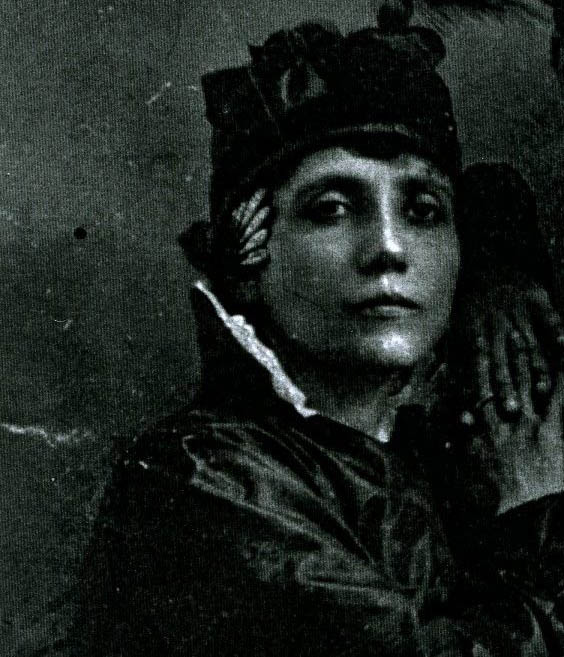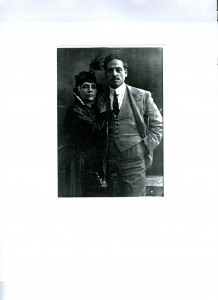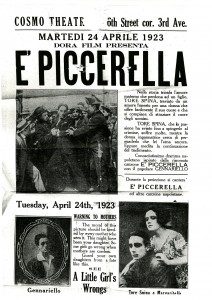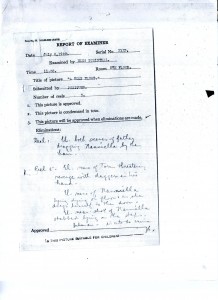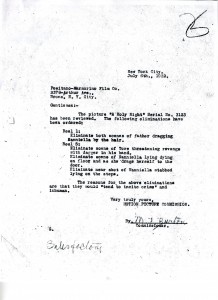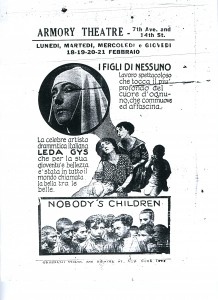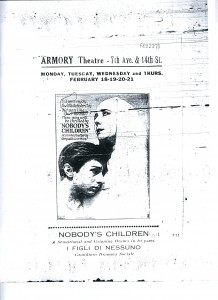According to her son Eduardo, who described her in interviews as having an authoritarian attitude or piglio, Elvira Notari was called “The General.” She earned the nickname from the strong will and determination she exhibited as head of the Dora Film Company in Naples, Italy (Masi and Franco 49). Director, actress, screenwriter, producer, and distributor, Elvira Notari is now celebrated as Italy’s first and most prolific film director. Over the course of 25 years in which she made 60 feature films and hundreds of shorts and actualities, she led Dora Film to become one of Naples’s leading production houses.
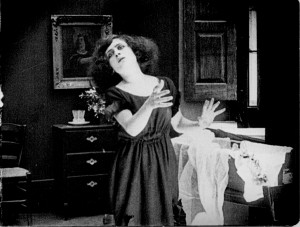
Frame enlargement, Rosè Angione as Nanninella in ‘A Santanotte (1922). Courtesy of the Cineteca di Bologna.

Frame enlargement, Eduardo Notari as Gennariello in Fantasia ‘e surdato (1927). Courtesy of L’immagine Ritrovata.
Working alongside Elvira was her husband Nicola,who was responsible for camerawork, and their son Eduardo, affectionately known as Gennariello from the character he played. The company was named Dora after the Notaris’ youngest child, although she never worked in the business. Like other artisanal family businesses, the Notari business started small, with the opening of a photographic laboratory in 1905. Their specialty, hand-colored moving pictures, distinguished them among others, as did the Arriverderci ed Augurali, which were brief hand-colored film titles, also called visual postcards, that they produced to preview coming events and attractions (Bernardini 1982, 119; Miscuglio and Daopoulo 243).
By 1912, Dora Film became a full-fledged production house after the Notaris built a teatro di posa (stage set) at their home in the Ponti Rossi section of Naples. In an apartment adjacent to their residence, Elvira founded an acting school for young, aspiring nonprofessionals (Masi and Franco 49; Bernardini 1982, 174). Eduardo’s schoolteacher, the beautiful and sensuous Rosè Angione, was featured as a femme fatale in many of Notari’s films. In ‘A Santanotte (1922) she played the role of a lower class café waitress. In contrast to the glamorous and elaborately costumed bourgeois and aristocratic divas of Italian cinema, Angione’s natural beauty and fiery, sexual demeanor offered audiences an alternative to the traditional femme fatale.
Notari’s acting methods merit some discussion as she is generally credited for presenting a realistic form of popular cinema. In interviews, her nephew Armando has described how his aunt, consistent with her nickname “The General,” was not only severe, but extremely picky. For example, she forbade players to use glycerin to artificially stimulate tears. Instead, on the set, Notari would bring up a painful or emotionally sensitive episode or detail of a player’s private life until an emotional response was achieved, and then she would order the camera to roll (Miscuglio and Daopoulo 248).
Notari incorporated the notion of typeage to create and develop players with regionally distinct facial features and body physiognomies that were codified to display a range of familiar repeated attitudes, gestures, and behaviors. With his slender physique, large, dark eyes and high, bushy hair, Gennariello epitomized the southern subaltern in his role as the good street urchin; local “black boot,” or shoeshine; or ‘guaglione ‘e core (good-hearted kid). Later he was given a series of his own based on that character. An unsettling figure, he was often the gauge by which critics judged Notari’s films as either degenerative displays of lower class vulgarity or artistic works of moral value and truth. Local critic Giuseppe Fossataro emphasized the educative influence of Notari’s films by praising Genariello’s emotionally convincing performances: “I saw tears in the eyes of those sitting next to me during the fourth part of A mala nova where the son of Mrs. Notari confirmed himself a true artist” (Troianelli 74).
In addition to relatives and friends, members of the Naples artistic community participated in Dora Film production activities, including Michele di Giacomo, brother of the illustrious poet Salvatore, who is said to have authored some of Notari’s films. In several interviews, however, Gennariello insists that his mother was responsible for directing and writing all of Dora Film’s productions, including adaptations:
Contrary to what is written in the general histories, all misinformed, my mother directed all of the films we produced, from the first to the last, including the seventy features. Not only this, she was also the author of the original subjects and adaptations (Miscuglio and Daopoulo 245).
Unlike many Italian women of her time, Notari graduated from high school and was educated in literature and danced as a hobby. She acted in her first films, including La figlia del Vesuvio (1912), and directed and wrote short topical subjects. With Italy’s involvement in the Libyan War in 1912, Elvira Notari directed a number of films that focused on news events related to the conflict, including Eroismo di un aviatore a Tripoli (1912), shot locally but advertised as shot on location. In Guerra italo-turca tra scugnizzi napoletani (1912), she cleverly captured Neapolitan children and street urchins, including her then ten-year-old son Gennariello as a fearless bandleader of an Italian street gang engaging in battle with a Turk gang that is dispersed under a hail of stones. Other films Notari directed in support of the Libyan war effort include Sempre avanti, Savoia! (1915), Addio, mia bella addio… l’armata se ne va (1915), and Gloria ai caduti (1916). Whether she intended these films to be vehicles of propaganda or simply portrayals of newsworthy events is not clear.
Notari made films geared for Neapolitans, especially middle-class women, that were full of cultural references and familiar social settings. She first looked to Neapolitan popular literature, specifically the serial novel form, as a source, as in Ciccio il pizzaiuolo del Carmine (1916), Il barcaiuolo di Amalfi (1918), and La Medea di Portamedina (1919), all based on feuilletons by Francesco Mastriani. She also wrote and directed screen adaptations of successful novels, including Chiarina la modista, by well-known Turinese author Carolina Invernizio. Women were at the center of these domestic melodramas filled with unsettling depictions of tragic and cruel figures. For example, Il nano rosso (1917), based on Invernizio’s novel Raffaella o I misteri del vecchio mercato, is a story about a deformed wealthy man who becomes enamored with a chorus girl and then depletes his fortune to conquer her affections, only to be betrayed when she leaves him. When he discovers the truth, he kills himself.
Melodrama was also a vehicle for Notari’s later “city films,” where local street life became the center of stories with criminal settings such as prison cells. Thus they featured representations of deviant behavior, including knifings, suicides, and violent acts of revenge. By the early 1920s, Notari, while continuing this thread, shifted her focus to a new artistic form, the sceneggiata, a hybrid theatrical form drawing on popular dramatic songs and the variety stage, producing films geared not only to local Neapolitan audiences, but also to Italian immigrants living overseas. Notari was quick to recognize the marketability of the musical narrative form, which was conventionalized around 1919, around the same time she began producing filmed sceneggiate. Songs had been an earlier source for Notari, but the film sceneggiata was a distinctly Neapolitan regional expressive form that quickly developed into a trademark genre of companies from the Parthenopean region.
During the 1920s Dora Film distributed their filmed sceneggiate to overseas markets with Italian immigrant populations, in the United States, for example, to Baltimore and New York, as well as to South American cities. Often the film prints were accompanied by singers who performed the soundtrack (Bruno 1997, 51). Of the few surviving prints of Notari’s entire film career, all are sceneggiate or fragments of the form, although Fantasia ‘e surdate (1925) is incomplete and was reedited by Notari after it did not pass Fascist censorship.
A Santanotte (1922) merits further discussion since the film was recently restored between 2007 and 2008 after an American distribution copy was discovered at the George Eastman House. It is widely accepted that Notari’s films were refused censorship visas by Roman authorities and were then smuggled into the United States, where they were popular, as many ads verify. However, documents located in the New York State Archives reveal that Dora Film faced similar problems with United States censors. Reports stipulate that violent scenes in ‘A Santanotte showing the father character, Guiseppone, beating his daughter Nanninella and dragging her by the hair, should be removed because they were “inhuman, and incite to crime.” Similarly, depictions of physical violence, drinking, and “unacceptable conduct” were cited as reasons for rejecting other films. The two prints used to restore ‘A Santanotte, one an Italian, the other an American reissue copy, each contain pertinent scenes, frames, intertitles, and tinting information that, when combined together, provide a clearer picture of Notari’s original film, the goal of the restoration, on which see Pozzi and De Sanctis.
Censorship is only one of the factors to be considered when speculating about Elvira Notari’s departure from the cinema. Masi and Franco suggest that with the increased difficulty of Fascist intervention at home, Notari abandoned her traditional repertoire and made a Hollywood-style sound film Napoli terra d’amore (1928) featuring Gennariello as a jazz musician. They claim that the film was a disaster with Notari’s public, particularly because a soundtrack replaced live singers (111-112). While Notari’s Trionfo cristiano (1930) is said to have revived the company, the exact date of its release is unclear since a longer title is listed as 1924 or 1925. The 1930 date may reflect the year of its US release while earlier dates may refer to years of production. The film is about the life of the local patron saint (San Pellegrino) and his triumph over sexual temptation, a film said to have been commissioned by a group of Italian-American immigrants from Altavilla Irpina (Masi and Franco 23; Bruno 1997, 53). Masi and Franco think that the religious slant of the film, in which Gennariello undergoes a transformation from guaglione ‘e core to holy martyr, suggests that Dora Film had changed its identity (124). But another explanation for the turn to religious themes may have been nothing more than their popularity. American newspapers promoting Nobody’s Children (1926) depict a saintly nun, as played by Neapolitan Lyda Gys, wife of distributor and producer Gustavo Lombardo. If we see this as a reference to The White Sister (1923) starring a saintly, de-sexualized Lillian Gish in a similar role, we might conclude that Notari was keeping abreast of market trends as she had always done, whether her audience was in New York or in Altavilla Irpina.
Undoubtedly, Fascism played a decisive role in the eventual closing of Dora Film. The discovery of more prints and further research into censorship documentation from Italy, the United States, and other countries where Notari’s films were distributed will help us to determine the degree to which her pictures were altered. Although her husband and son remained active in the film industry in the 1930s, Notari apparently lost her momentum and left the cinema to retire in Cava dei Tirreni, where she died on December 17, 1946.

